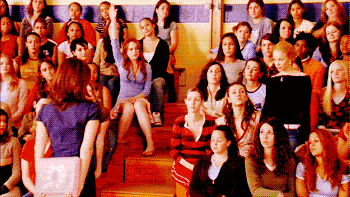Since that time, Ancestry.com has published a staggeringly large collection of Quaker records online. These include their meeting minutes, as well as vital statistics that were kept and shared across the Quaker communities of Pennsylvania and New Jersey.
Anyone in the loop on such things will know that this collection at Ancestry.com isn't exactly new. It's been around for several years, and I've just never gotten around to exploring it all yet. Well, I decided today to stop making excuses and just start in. And I'm glad I did, because I got to engage in my favorite kind of genealogy as I did so.
Mythbusting: Rebecca Silverthorn
In my previous post, I mentioned John Lundy and his wife Rebecca Silverthorn, and how they seem to be at the breaking point of not only the united Quaker family living in one place. What I didn't realize, until I starting digging through the records, is their move to Grayson County, Virginia signified more than a break in geographical familial closeness.
It all begins with Rebecca Silverthorn.
Looking at this page from Exeter Meeting Minutes, compiled in 1930 by John E. Eshelman with all of its vital statistics written in neat columns, you'd be inclined to assume that she is a Quaker. Armstrong fails to address this assumption in the book he published in 1902, mentioning records out of context that appear to favor that conclusion.
But thanks to digitization, we have access to the records that do not leave us in doubt. As always, taking a tour through all of the available records reminds us why this should be standard procedure for every claim we make, or fail to make.
Rebecca Silverthorn was not a Quaker. When trying to research her marriage to John Lundy, her name appears in none of the local meeting minutes from the time of the marriage, as suggested by Armstrong. For a Quaker marriage, this is highly unusual. Multiple marriage announcements over weeks (and sometimes months) show up in at least half a dozen meeting minutes, from multiple publications within the community.
If Rebecca Silverthorn was a Quaker, the proof would be in pudding when it comes to Quaker records. She would be communicating her intentions far and wide within the necessary circles. Instead, the page posted above is the only mention I could find of her name in any available Quaker meeting minutes. And it was obviously written as an assemblage of history, not an account of current circumstances.
Disownment among the Quakers
Rebecca doesn't show up in Quaker records because she isn't a Quaker. Nevertheless, they were married 11 December 1777 in Hunterdon County, New Jersey. John did not seek approval from those within his society, and was not married according to their custom. The Kingwood/Quakertown Monthly Meeting minutes from December 1777 announce John's marriage, failing to mention Rebecca's name. They also mention his confession, which was not uncommon in cases of "marrying out."
As a Quaker, this meant that John Lundy would be subject to the disciplinary action of disownment. The society would investigate his conduct. John would then either offer a statement of apology and testimony in a public meeting or, barring any such formal apology, the society would issue charges against him. They would then set about to reform him, until such an apology would be made. If reform proved impossible, the Society would disown his actions. This was largely a financial punishment, barring him from doing business with other Quakers. According to this source, disownment had no other social or religious consequences.
In January 1778, John Lundy's "paper of acknowledgement is received." Whether this means the congregation received his acknowledgment of his misconduct, or he received a letter of his charges, the meeting minutes do not elaborate. I'm leaning more towards he gave his own statement of apology, because his name disappears from the meeting minutes. He is no longer the focus of prolonged ministering, suggesting he had reformed himself to their satisfaction, and his matters were fully resolved.
John Lundy doesn't reappear in the Quakertown Meeting Minutes until he requests a certificate of removal to the Deep River Meeting of North Carolina in February 1785. A letter of recommendation to assure a new congregation of his good standing in the community, John's request was refused for several months, from February to September of that same year.
Knowing that he eventually settles in Grayson County, Virginia, I'm trying to piece together his whereabouts using more Quaker meeting records. His name slips away quietly out of the Kingwood Monthly Meeting Records in New Jersey, but fail to reappear as anticipated in the Deep River Monthly Meeting Minutes. (Note: This collection exists somewhat piecemeal on Ancestry.com, and the Deep River Monthly Meeting is listed under Guilford County, North Carolina)
I will continue exploring these records, piecing together the generation that relocated to Virginia and North Carolina as best I can. Most of what I'm currently finding in the Deep River Monthly Meeting Minutes are John's relations and children, but never John himself. I'm also hoping that by searching for his children in the meeting minutes both North and South, I can more readily lay out his whereabouts. He was having children throughout the 1780s, at the time of his move, so such a course would not be remiss.








































